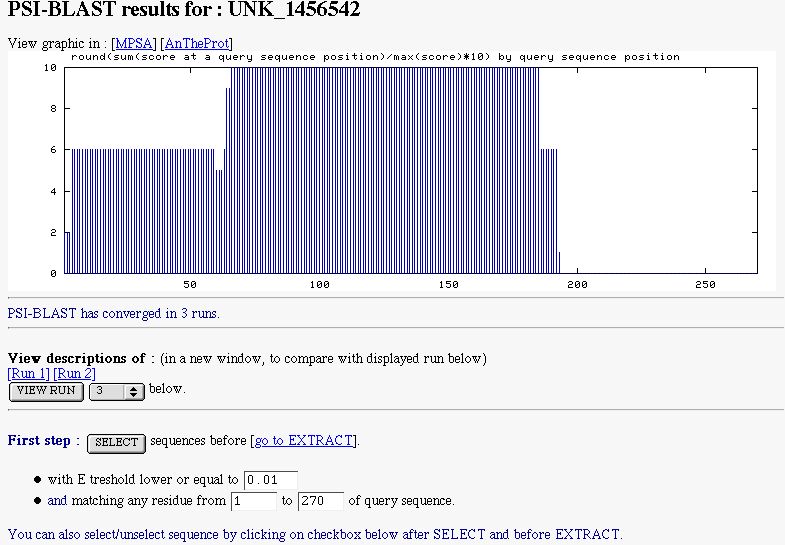PSI-BLAST help
 A brief introduction to PSI-BLAST
A brief introduction to PSI-BLAST
The BLAST algorithm could use a position-specific matrix (profile) in place of a query sequence and associated substitution matrix. The
PSI-BLAST (Position-Specific Iterated BLAST) is an automated procedure generating the matrix from BLAST result and a modified BLAST
algorithm to take as input this matrix. The PSI-BLAST is an iterative process with a first step being a standard BLAST.
For further details, see the NCBI PSI-BLAST tutorial.
 Availability in NPS@
Availability in NPS@
PSI-BLAST is available :
So, for example, you can use PSI-BLAST to find similar sequences in a database built from an
ACNUC query or after a
PATTINPROT search.
 Parameters
Parameters
PSI-BLAST parameters are not currently available for the user.
By default the number of description and the number of alignment are set to 500.
The expected threshold is set to 10.0.
The comparison matrix is BLOSUM62.
The default behavior is selected for gap opening (11) and gap extending (1) costs.
The expectation value threshold for inclusion in multipass model is 0.01.
The maximum number of passes is 10.
To retrieve these informations see the line "Information and statistics : [PSI-BLAST]" in
NPS@ PSI-BLAST result file.
 NPS@ PSI-BLAST output example
NPS@ PSI-BLAST output example
The NPS@ PSI-BLAST output is divided into three parts.
-
PART 1:
In this part, you have :
- A graphic indicating the similarity found along the query sequence. It's computed from PSI-BLAST alignment. This graphic
can be see in MPSA/ANTHEPROT to determine interesting boundaries in the query sequence.
- A line to say if PSI-BLAST has converged or not.
- A form to select the run to display.
- A form to select subject sequences. You can select sequences by indicated the maximal E threshold to do it (by default
NPS@ sets it to expectation value threshold for inclusion in multipass model). You can also select
subject sequences matching a particular region of the query.

-
PART 2:
It's the PSI-BLAST description block in a 'HTMLized' form.
You can see :
- A checkbox to select/unselect subject sequence.
- The NPSA link allows you to apply
NPS@ methods on the corresponding sequence after it is extracted from the query database.
- The database link to retrieve the database entry.
- The alignment link (on expected value) to see PSI-BLAST alignment between the query sequence and the current subject
sequence.
- The number of displayed sequences.
- The number of selected sequences.

-
PART 3:
You have :
- An extract form to extract selected sequence and make a database. You can extract full or partial sequences.
The full extract is made from the database.
The partial extract, is made for subject sequence that match the query one in the indicated region. The extracted sequence
is retrieved from the PSI-BLAST alignment. You can set the minimal length of the extracted sequence.
- A checkbox to add your query sequence in the created
database.
- A checkbox to remove identical sequences in the created
database.
- A link on PSI-BLAST information and statistics.
- A link on the original PSI-BLAST result text file.

 References
References
 A brief introduction to PSI-BLAST
A brief introduction to PSI-BLAST

